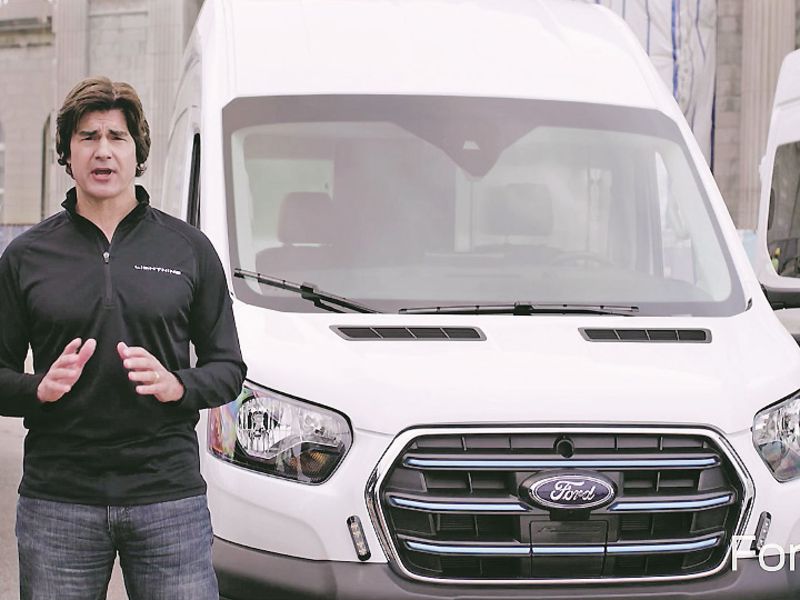
DETROIT — Ford Motor Co.’s segment-leading commercial vans and trucks provide steady profits year in and year out, but they get little of the attention or publicity that its higher-profile retail business generates.
That’s about to change.
The automaker’s commercial offerings will take a starring role under CEO Jim Farley and the “Ford+” growth plan he laid out last week. Ford is separating the part of its business aimed at commercial customers into a standalone unit called Ford Pro, and it expects to nearly double the revenue it generates to $45 billion by 2025.
The company hopes Ford Pro will help it boost recurring revenue from data-focused subscription services, reduce ownership costs for fleet operators and grow its commanding 43 percent share of the commercial van and truck market.
Farley called the new entity “one of the most important strategic initiatives at Ford in many, many years.” Wall Street appears to agree.
Ford shares surged last week to a five-year high after Farley’s investor presentation, when executives also laid out plans to increase the company’s investment in electric vehicles and boost sales of EVs to 40 percent of global volume by 2030.
“Highly encouraging to see a coherent strategy under world-class management,” Morgan Stanley analyst Adam Jonas said in an investor note. “What stood out to us the most is that the company is doubling down on where it is strong or can be strong: (a) relationships with commercial customers, (b) authentic/experiential consumer and commercial brands, (c) exiting/partnering on areas where the company has a low likelihood of winning.”
Ford is banking on fleet operators making EVs such as the E-Transit and newly unveiled F-150 Lightning successful.
“More than any other customer segment, our commercial customers will lead the connected and electric vehicle tech transformation,” Ford Pro CEO Ted Cannis said. “The benefits directly hit their bottom line.”
Ford Pro’s goal, Farley said, is to “put more connected fleets on the road than any of our competitors.”
Ford already has roughly 125,000 active fleet customers in North America and hopes to capture more with its pair of upcoming battery-electric vehicles. Ford says the Transit and F-150 made up more than 40 percent of its commercial sales in North America last year and that most of its fleet operators replace 10 to 15 percent of their vehicles every year.
The “connected” part of Ford’s plan will come from what it calls Blue Oval Intelligence, a cloud-based platform for linking electrical, power distribution, computing and software systems in Ford and Lincoln vehicles. Using that platform, Ford recently began offering over-the-air updates, which it calls “Ford Power-Ups,” and expects to have 33 million vehicles enabled for such updates on the road by 2028.
It’s part of Ford’s effort to transition from a transaction-oriented business to what it calls an “always on” relationship with customers.
For commercial buyers, connected vehicles mean opportunities for fleet owners to schedule maintenance, monitor driving habits and coordinate charging times for EVs.
Ford Pro customers also can use roughly 300 upfitters in North America that are able to service both electric and gasoline-powered versions of the F-150 and Transit.
The business unit will offer a new, dedicated financing service for commercial customers called Ford Pro FinSimple. The platform will offer bundled financing for vehicles, services and EV charging.
Ford says it wants to grow its commercial financing share from 10 to 24 percent by 2025.
Beyond the added revenue, Farley said Ford Pro essentially will be a test case as it expands EVs and connected services.
“For the company, the strategic [advantages] go way beyond growth in revenue and [profits] in commercial,” Farley said. “With the large install base we accelerate our BEV scale and we learn from the deployment of connected services that create a major advantage as we expand digital ownership experiences to our retail customers.”
Beyond its commercial vehicle plans, Ford’s pitch to investors last week centered on growing its EV offerings.
The company said it will spend $30 billion on electrification through 2025, $8 billion more than it previously planned. Ford CFO John Lawler said that additional spending will be focused on battery production, as the company plans to launch a line of batteries called IonBoost made in partnership with SK Innovations.
Hau Thai-Tang, Ford’s chief product platform and operations officer, said the automaker would offer two new EV architectures: a rear-wheel-drive/all-wheel-drive platform and a platform dedicated to full-size pickups.
The rwd/awd platform “will underpin a range of emotive vehicles slated for production between now and 2030,” Thai-Tang said, including electric versions of the Explorer and Lincoln Aviator, a midsize pickup and a “rugged SUV.”
Farley said that, by 2030, Ford expects that four out of every 10 vehicles it sells globally will be an EV. The company stopped short of setting an all-EV target in the U.S. like General Motors has, but Farley took a swipe at GM’s 2035 goal by noting that Ford’s proclamation was “not an aspiration; it’s what we’re planning on doing.”
Jonas, in his investor note, said Ford’s plans may help it catch up to its rival.
“We think there are elements of Ford’s presentation/strategy and business mix that are on par and even above GM’s,” he said. “And while Ford may have a later start than GM in some important areas (i.e. battery cell vertical integration) we believe over time such differences may get smoothed out.”